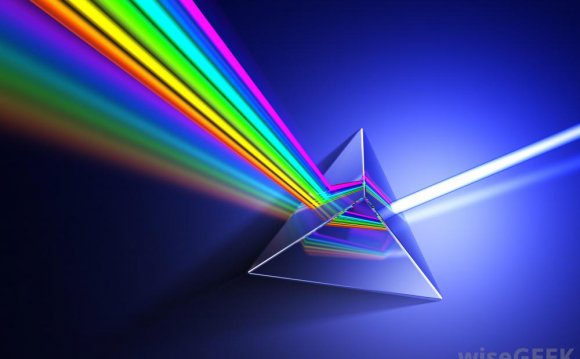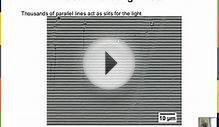
Diffraction grating ![Diffraction grating [Credit: Zaereth]](/img/diffraction_grating_credit_zaereth.jpg) Diffraction gratingZaereth component of optical devices consisting of a surface ruled with close, equidistant, and parallel lines for the purpose of resolving light into spectra. A grating is said to be a transmission or reflection grating according to whether it is transparent or mirrored—that is, whether it is ruled on glass or on a thin metal film deposited on a glass blank. Reflection gratings are further classified as plane or concave, the latter being a spherical surface ruled with lines that are the projection of equidistant and parallel lines on an imaginary plane surface. The advantage of a concave grating over a plane grating is its ability to produce sharp spectral lines without the aid of lenses or additional mirrors. This makes it useful in the infrared and ultraviolet regions in which these radiations would otherwise be absorbed upon passage through a lens.
Diffraction gratingZaereth component of optical devices consisting of a surface ruled with close, equidistant, and parallel lines for the purpose of resolving light into spectra. A grating is said to be a transmission or reflection grating according to whether it is transparent or mirrored—that is, whether it is ruled on glass or on a thin metal film deposited on a glass blank. Reflection gratings are further classified as plane or concave, the latter being a spherical surface ruled with lines that are the projection of equidistant and parallel lines on an imaginary plane surface. The advantage of a concave grating over a plane grating is its ability to produce sharp spectral lines without the aid of lenses or additional mirrors. This makes it useful in the infrared and ultraviolet regions in which these radiations would otherwise be absorbed upon passage through a lens.
The lines on gratings are made by an extremely precise machine called a ruling engine, which uses a diamond-tipped tool to press thousands of very fine, shallow lines onto a highly polished surface. Newer techniques rule the lines photographically, using laser interferometry.
A diffraction grating is able to disperse a beam of various wavelengths into a spectrum of associated lines because of the principle of diffraction: in any particular direction, only those waves of a given wavelength will be conserved, all the rest being destroyed because of interference with one another. Gratings give exceptionally high resolutions of spectral lines. The resolving power () of an optical instrument represents the ability to separate closely spaced lines in a spectrum and is equal to the wavelength λ divided by the smallest difference (Δλ) in two wavelengths that can be detected; i.e., R = λ/Δλ. Thus, for a grating 10 centimetres wide and ruled with 10, 000 lines per centimetre, the resolution in the first diffraction order would be 100, 000. For a wavelength emission in the ultraviolet, say λ = 300 nanometres (3 × 10-7 metre), a wavelength difference of Δλ = 3 × 10-12 metre (about 1/100 the diameter of an atom) should be theoretically possible.
department of education jobs difference between blogging and content writing nurse education keypath education blog not even wrong blogging recipes education journals special education schools blog contra incendios blogging on google blogging in education remote higher education jobs blogging keyword research tools esea education money education blogging through pinterest blog inside paradeplatz whats health education blogging jobs online az department of education blog among us how to make money while blogging difference between blogging and social media new york state education department what is stem education special education week blogging conferences 2022 blogging que es blogging income after 1 year illuminate education blogging with medium blog kraken ventura county office of education blogging under your own name mass department of education blog on google sites national center for education statistics blog out foundation for individual rights in education blogging niche ideas childhood education blogging boys blog editor blogging after retirement new oriental education stock difference between blogging and microblogging osha education center elmore county board of educationRELATED VIDEO










